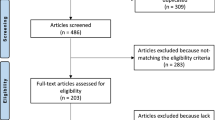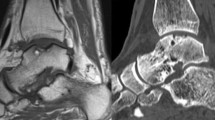Abstract
Introduction
Chondral and osteochondral lesions of the talus (OLTs) remain a challenging issue with numerous operative treatments proposed to date. The aim of this study was to evaluate 1-year follow-up data in the German Cartilage Registry (KnorpelRegister DGOU).
Methods
Among 401 patients in the database, 114 patients with a complete 1-year Foot and Ankle Outcome (FAOS) score for subscale Pain as the primary variable were included. A total of 12 different surgical treatments were performed. However, 8 techniques were carried out in negligible numbers of patients (n = 1–3), leaving 89 patients treated with the following techniques: arthroscopic antegrade bone marrow stimulation (group A; n = 32), autologous chondrocyte implantation with autologous cancellous bone grafting (group B; n = 9), matrix-augmented bone marrow stimulation (group C; n = 22), and matrix-augmented bone marrow stimulation with autologous cancellous bone grafting (group D; n = 26). Group differences and possible influencing variables such as age and sex were evaluated. Level of significance was set at p < 0.05 for all statistical tests.
Results
All four treatment groups showed significant improvement of the FAOS scores at 1 year postoperatively compared with their preoperative scores. No significant differences were found with respect to score changes among the groups. A positive correlation between FAOS subscale Pain improvement and defect size volume and negative correlations between increasing age and FAOS subscales Sports/Rec and QoL were found. Concomitant ankle stabilization led to greater improvement in FAOS subscales Symptoms and ADL than in patients with no stabilization. FAOS subscale Pain showed greater improvement in women than in men.
Conclusion
All analyzed treatment options were effective for treatment of OLTs. In particular, large defects appeared to benefit from treatment. In the presence of concomitant ankle instability, a stabilizing procedure appeared to have a positive impact on the outcome.

Similar content being viewed by others
References
Baums MH, Heidrich G, Schultz W, Steckel H, Kahl E, Klinger HM (2006) Autologous chondrocyte transplantation for treating cartilage defects of the talus. J Bone Joint Surg Am 88(2):303–308
Becher C, Driessen A, Hess T, Longo UG, Maffulli N, Thermann H (2010) Microfracture for chondral defects of the talus: maintenance of early results at midterm follow-up. Knee Surg Sports Traumatol Arthrosc 18(5):656–663
Becher C, Thermann H (2005) Results of microfracture in the treatment of articular cartilage defects of the talus. Foot Ankle Int 26(8):583–589
Berndt AL, Harty M (1959) Transchondral fractures (osteochondritis dissecans) of the talus. J Bone Joint Surg Am 41-A:988–1020
Buda R, Castagnini F, Cavallo M, Ramponi L, Vannini F, Giannini S (2016) "One-step" bone marrow-derived cells transplantation and joint debridement for osteochondral lesions of the talus in ankle osteoarthritis: clinical and radiological outcomes at 36 months. Arch Orthop Trauma Surg 136(1):107–116
6Dambrosi R, Maccario C, Serra N, Ursino C, Usuelli FG (2017) Relationship between symptomatic osteochondral lesions of the talus and quality of life, body mass index, age, size and anatomic location. Foot Ankle Surg 10.1016/j.fas.2017.04.011
D’Ambrosi R, Maccario C, Ursino C, Serra N, Usuelli FG (2017) Combining microfractures, autologous bone graft, and autologous matrix-induced chondrogenesis for the treatment of juvenile osteochondral talar lesions. Foot Ankle Int 38(5):485–495
Galla M, Duensing I, Kahn TL, Barg A (2019) Open reconstruction with autologous spongiosa grafts and matrix-induced chondrogenesis for osteochondral lesions of the talus can be performed without medial malleolar osteotomy. Knee Surg Sports Traumatol Arthrosc 27(9):2789–2795
Giannini S, Buda R, Faldini C et al (2005) Surgical treatment of osteochondral lesions of the talus in young active patients. J Bone Joint Surg Am 87(Suppl 2):28–41
Hangody L, Kish G, Modis L et al (2001) Mosaicplasty for the treatment of osteochondritis dissecans of the talus: two to seven year results in 36 patients. Foot Ankle Int 22(7):552–558
Jungmann PM, Salzmann GM, Schmal H, Pestka JM, Sudkamp NP, Niemeyer P (2012) Autologous chondrocyte implantation for treatment of cartilage defects of the knee: what predicts the need for reintervention? Am J Sports Med 40(1):58–67
Kim SW, Jung HG, Lee JS (2020) Ligament stabilization improved clinical and radiographic outcomes for individuals with chronic ankle instability and medial ankle osteoarthritis. Knee Surg Sports Traumatol Arthrosc 28:3294–3300
Korner D, Ateschrang A, Schroter S et al (2020) Concomitant ankle instability has a negative impact on the quality of life in patients with osteochondral lesions of the talus: data from the German Cartilage Registry (KnorpelRegister DGOU). Knee Surg Sports Traumatol Arthrosc 28:3339–3346
Kubosch EJ, Erdle B, Izadpanah K et al (2016) Clinical outcome and T2 assessment following autologous matrix-induced chondrogenesis in osteochondral lesions of the talus. Int Orthop 40(1):65–71
Murawski CD, Kennedy JG (2013) Operative treatment of osteochondral lesions of the talus. J Bone Joint Surg Am 95(11):1045–1054
Oakley SP, Portek I, Szomor Z et al (2003) Accuracy and reliability of arthroscopic estimates of cartilage lesion size in a plastic knee simulation model. Arthroscopy 19(3):282–289
17Pinski JM, Boakye LA, Murawski CD, Hannon CP, Ross KA, Kennedy JG (2016) Low level of evidence and methodologic quality of clinical outcome studies on cartilage repair of the ankle. Arthroscopy, 32(1):214–222 e211
Roos EM, Brandsson S, Karlsson J (2001) Validation of the foot and ankle outcome score for ankle ligament reconstruction. Foot Ankle Int 22(10):788–794
Schafer D, Boss A, Hintermann B (2003) Accuracy of arthroscopic assessment of anterior ankle cartilage lesions. Foot Ankle Int 24(4):317–320
Valderrabano V, Miska M, Leumann A, Wiewiorski M (2013) Reconstruction of osteochondral lesions of the talus with autologous spongiosa grafts and autologous matrix-induced chondrogenesis. Am J Sports Med 41(3):519–527
van Dijk CN, Reilingh ML, Zengerink M, van Bergen CJ (2010) Osteochondral defects in the ankle: why painful? Knee Surg Sports Traumatol Arthrosc, 18(5):570-580
Walther M, Altenberger S, Kriegelstein S, Volkering C, Roser A (2014) Reconstruction of focal cartilage defects in the talus with miniarthrotomy and collagen matrix. Oper Orthop Traumatol 26(6):603–610
Acknowledgements
The German Cartilage Registry (Knorpel- Register DGOU) is initiated by the Working Group Clinical Tissue Regeneration and supported by the Deutsche Arthrose-Hilfe e.V. and the Stiftung Oskar-Helene-Heim.
Funding
For this study, data from the German Cartilage Registry (KnorpelRegister DGOU) were used, which is financially supported by the Deutsche Arthrose-Hilfe e.V. and the Stiftung Oskar-Helene-Heim.
Author information
Authors and Affiliations
Corresponding author
Ethics declarations
Conflict of interest
The authors declare that they have no conflict of interest.
Ethical approval
The local ethic committees at all participating clinical centers gave their approval.
Informed consent
Informed consent was obtained from all individual participants included in the registry.
Additional information
Publisher's Note
Springer Nature remains neutral with regard to jurisdictional claims in published maps and institutional affiliations.
Rights and permissions
About this article
Cite this article
Ettinger, S., Gottschalk, O., Kostretzis, L. et al. One-year follow-up data from the German Cartilage Registry (KnorpelRegister DGOU) in the treatment of chondral and osteochondral defects of the talus. Arch Orthop Trauma Surg 142, 205–210 (2022). https://doi.org/10.1007/s00402-020-03631-z
Received:
Accepted:
Published:
Issue Date:
DOI: https://doi.org/10.1007/s00402-020-03631-z




